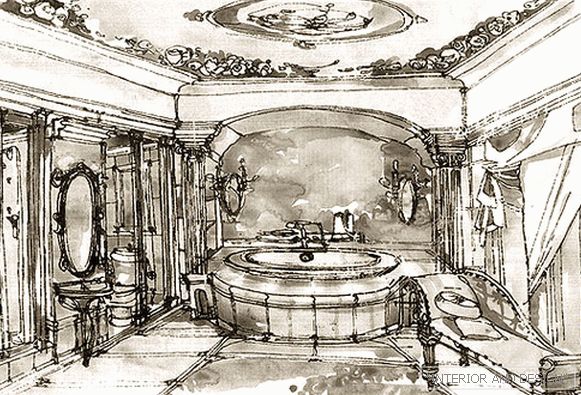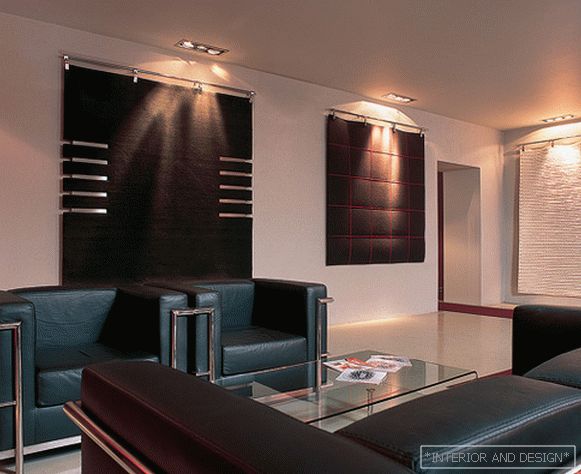The exhibition of genius Iris van Herpen takes place in Atlanta. A retrospective of Transforming Fashion (“Changing the Fashion”) at High Museum of Art’s shows a portfolio of one of the most original designers of our time: 45 incredible dresses from 15 collections from 2008 to 2015.
The girl from the Dutch province in the early 2010 became a world celebrity. Now the name Iris van Herpen sounds as loud as the names of its teachers Victor Horsting, Rolf Snoren and Alexander McQueen.
Айрис ван Херпен (р. 5 июня 1984 г.) изучала дизайн в институте искусств ArtEZ в Арнхеме, после стажировалась в студии МакКуина в Лондоне, у Victor&Rolf в Париже и Клоди Йонгстра в Амстердаме. Бренд Iris van Herpen дебютировал в 2007 году с головокружительной коллекцией Fragile Futurity, размышлениями о будущем в мире космических достижений.
Iris van Herpen does what the best furniture suite designers do: she stands for the interconnection of craftsmanship and the computer. A modern look at Haute Couture, which is based on both manual work and digital technology. Works Van Herpen more than fashion. She sews latex, plexiglass, carbon fiber and polyethylene terephthalate dresses. The shoes are made of jasper and agate, welded with fiberglass ... The forms of her dresses are the result of immersion in the structure of living cells and microorganisms. Sources of inspiration: a large hadron colider, modern Amsterdam architecture, Tesla coils, etc.
“For me, fashion is an expression of art that is very closely connected with me and my body. I see in it an expression of my identity in combination with mood and culture. Through all my work, I make it clear that fashion is an artistic act, and not just a functional, empty or commercial tool. Wearing clothes is an exciting moment of self-expression. “Form follows function” is not my slogan. On the contrary, I believe that forms complement and change the body and, thus, emotions. ”
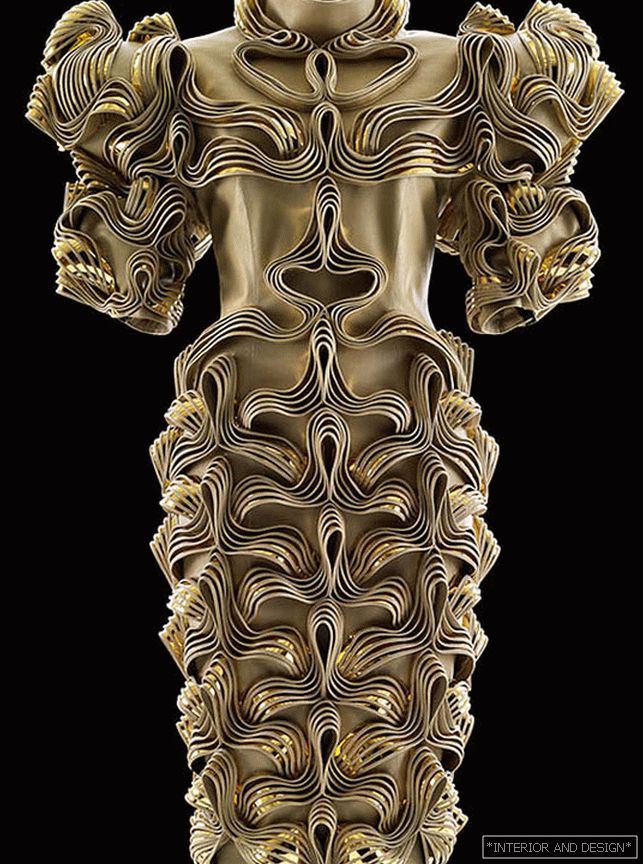 Dress Radiation Invasion, September 2009. Imitation leather, gold foil, cotton and tulle. From the collection of the Groninger Museum.
Dress Radiation Invasion, September 2009. Imitation leather, gold foil, cotton and tulle. From the collection of the Groninger Museum. 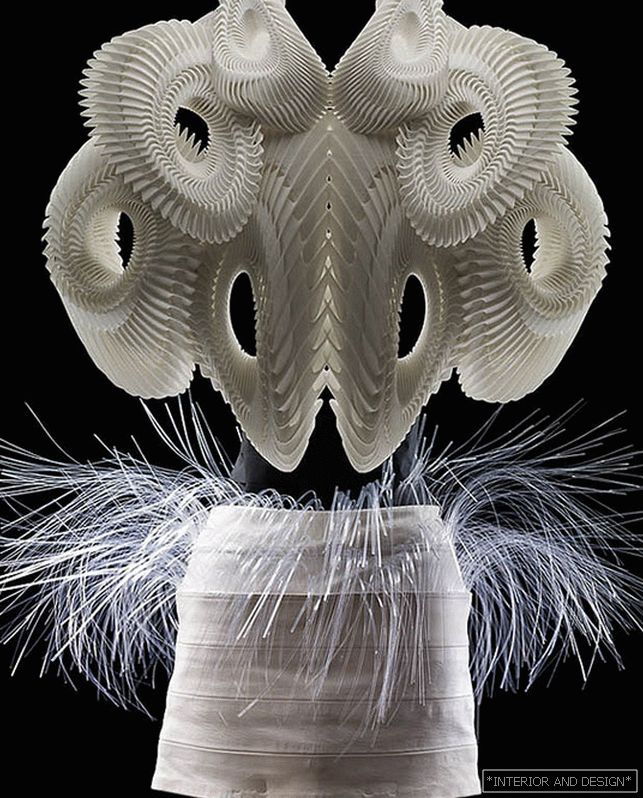 Skirt, top Crystallization, July 2010. In collaboration with Daniel Widrig and Materialize. 3D printing. Polyamide, goat leather and transparent acrylic sheets from laser treated. From the collection of the Groninger Museum.
Skirt, top Crystallization, July 2010. In collaboration with Daniel Widrig and Materialize. 3D printing. Polyamide, goat leather and transparent acrylic sheets from laser treated. From the collection of the Groninger Museum. 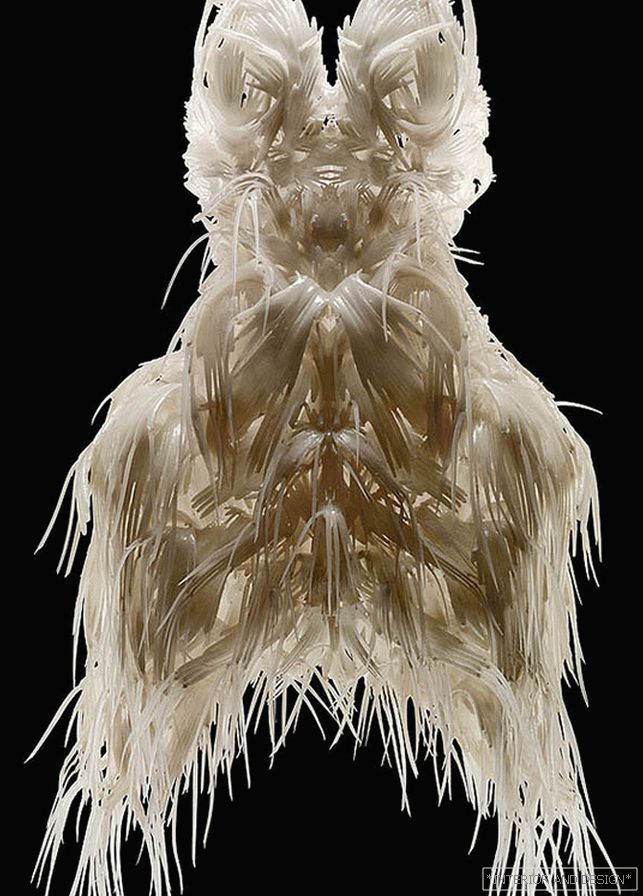 Dress Biopiracy, March 2014. In collaboration with Julia Kerner and the Materialize company. 3D printing. Polyurethane thermoplastic 92A-1 with silicone. From the collection of Phoenix Art Museum.
Dress Biopiracy, March 2014. In collaboration with Julia Kerner and the Materialize company. 3D printing. Polyurethane thermoplastic 92A-1 with silicone. From the collection of Phoenix Art Museum.  Dress Magnetic Motion, September 2014. In collaboration with Nikolo Casas and 3D Systems. 3D print, transparent photopolymer and plastic with stereolithography. High Museum of Art, Atlanta.
Dress Magnetic Motion, September 2014. In collaboration with Nikolo Casas and 3D Systems. 3D print, transparent photopolymer and plastic with stereolithography. High Museum of Art, Atlanta. 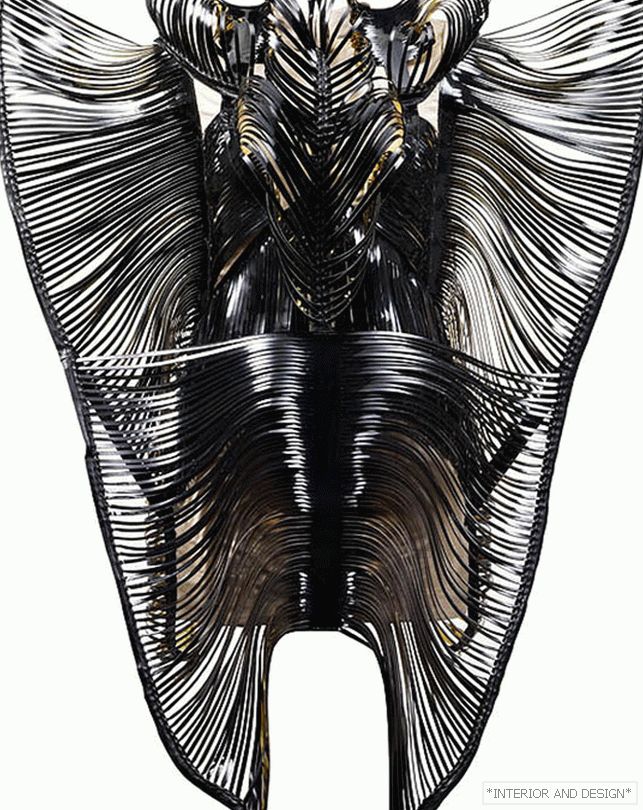 Dress Synesthesia, February 2010. Calf leather, gold leaf, metallic yarn, cotton. From the collection of the Groninger Museum.
Dress Synesthesia, February 2010. Calf leather, gold leaf, metallic yarn, cotton. From the collection of the Groninger Museum. The interdisciplinary method is broadcast today by designers of different directions and interests. Arik Levi complements industrial design with a sculpture, Rolf Zaks with photography and medicine, Tokujin Yoshioka with crystallography, Michael Young with fractal geometry. Fashion designer Rick Owens creates "wild" sofas and beds made of stone wood, and Matthew Williamson - the paradise gardens on the wallpaper. But the phenomenon of Iris van Herpen of a different plan, it goes beyond the scope of individual experiments. Iris is in constant readiness to explore new materials, quickly adopt the most advanced experiences and always act, balancing on the verge of science, philosophy, architecture. Her avant-garde is dramatic, sexy and full of emotion.
Five hits of the Transforming Fashion show in America:
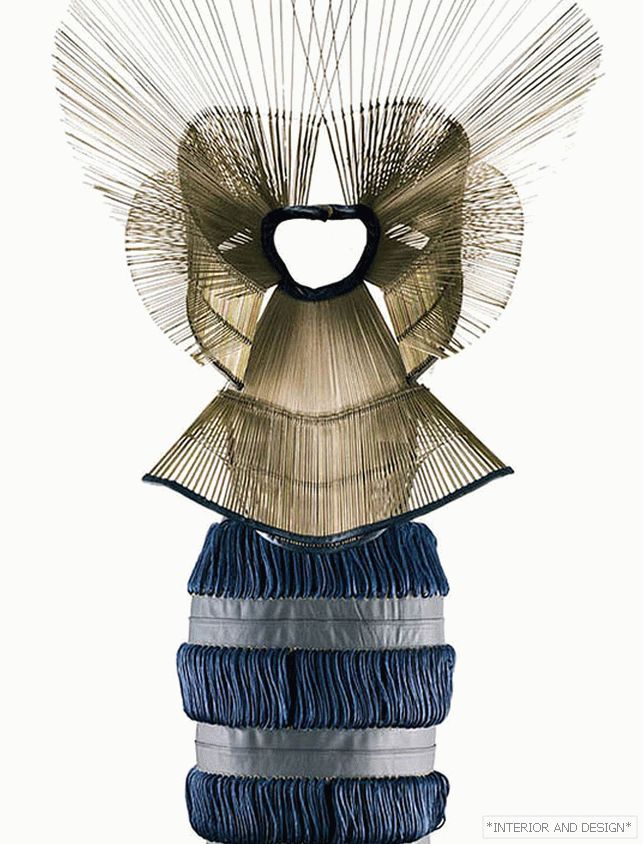 Collection Chemical Crows, January 2008. Children's umbrellas, industrial filaments, calfskin and metallic threads. From the collection of the Groninger Museum.
Collection Chemical Crows, January 2008. Children's umbrellas, industrial filaments, calfskin and metallic threads. From the collection of the Groninger Museum. 1. Chemical Crows ("Chemical Ravens"). Three dresses from the 2008 collection. 700 knitting needles from children's umbrellas are connected in designs resembling golden bird wings, waving in motion.
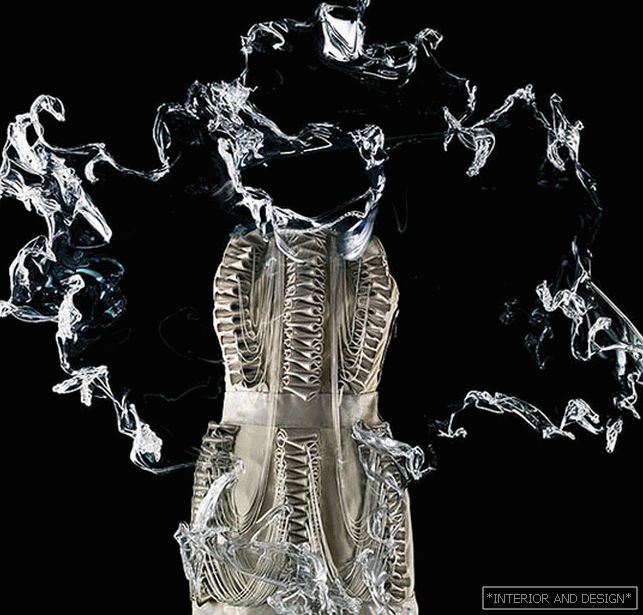 Dress Crystallization, July 2010. Transparent polyethylene terephthalate, ECCO leather, goat leather, silver chains, viscose. From the collection of the Groninger Museum.
Dress Crystallization, July 2010. Transparent polyethylene terephthalate, ECCO leather, goat leather, silver chains, viscose. From the collection of the Groninger Museum. 2. Crystallization ("Crystallization"). The outfit came thanks to the Benthem Crouwel Architekten Bureau, which built the new wing of the Stedelijk Museum in Amsterdam. The people called him “bath”. Iris decided to devote the collection to different states of water, as well as the transformation of chaos (water) into a crystalline structure. After testing about 40 different materials, Iris stopped on polyethylene terephthalate (PET), a pliable plastic commonly used to make plastic bottles. The dresses of this collection are a frozen splash of water, enveloping the figure with a transparent veil.
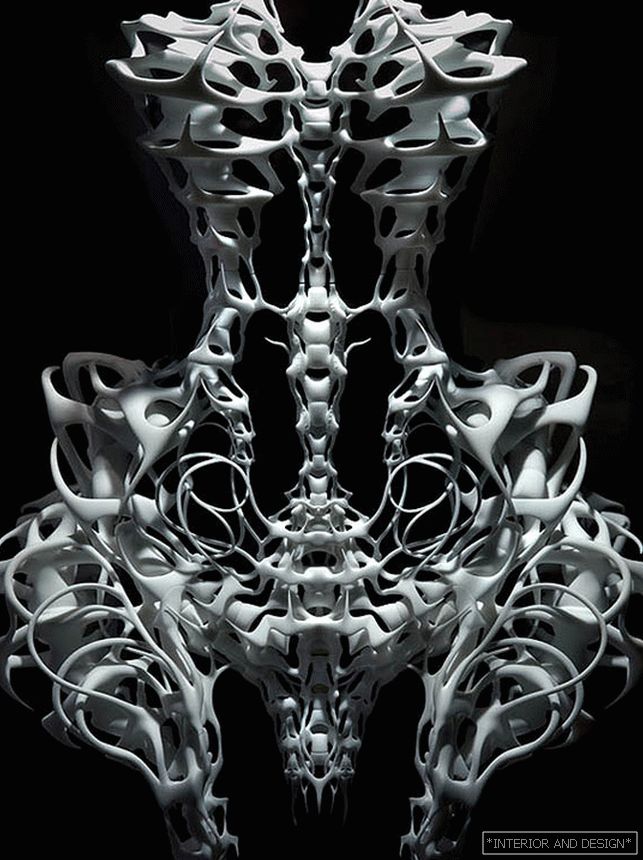 Capriole Ensemble, July 2011. In collaboration with Isaiah Block and Materialize. 3D printing Polyamide. From the collection of the Groninger Museum.
Capriole Ensemble, July 2011. In collaboration with Isaiah Block and Materialize. 3D printing Polyamide. From the collection of the Groninger Museum. 3. Capriole ("Каприоль"). The collection with which Iris van Herpen made her debut in Paris as a visiting member of the High Fashion Syndicate. Their French name 5 outfits received in honor of the equestrian term meaning "jump in the air." The designer sought to convey the sensations of free fall before and during the parachute jump. The Skeleton Dress was produced using 3D printing in collaboration with Belgian designer and architect Isaiah Block, who specializes in 3D designs. Van Herpen achieved the sophisticated sculptural quality of the dress thanks to the technology of selective laser sintering (SLS). This method gives the design flexibility and strength.
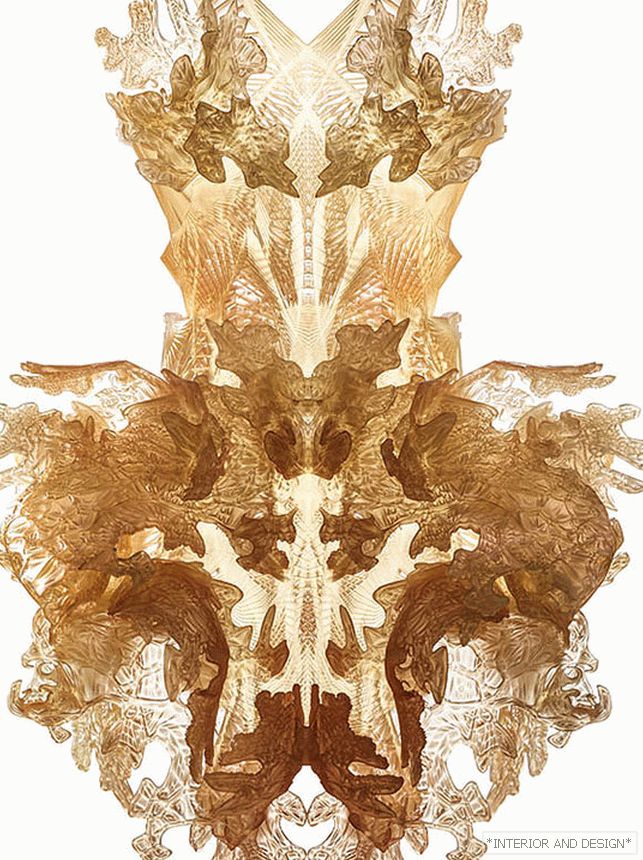 Dress Hybrid Holism, July 2012. In collaboration with Julia Kerner. 3D printing. UV polymer. From the collection of the High Museum of Art, Atlanta.
Dress Hybrid Holism, July 2012. In collaboration with Julia Kerner. 3D printing. UV polymer. From the collection of the High Museum of Art, Atlanta. 4. Hybrid Holism. The dress of complex honey shades is inspired by the image of a fractal (a geometric shape consisting of parts, each of which is a reduced copy of the whole) from an old Dutch book. Van Herpen collaborated with Austrian architect Julia Kerner in order to achieve a detailed repetition of the picture. The Belgian 3D printing company Materialize printed the dress using stereolithography. This process creates an object cut after cut, from bottom to top, in a vessel made of translucent polymer, which solidifies on contact with a laser.
 Dress Voltage, January 2013. Mirror foil, transparent acrylic sheet, viscose. Property designer.
Dress Voltage, January 2013. Mirror foil, transparent acrylic sheet, viscose. Property designer. 5. Voltage. Iris van Herpen explores the electricity of the body. The collection is based on the work of New Zealand experimenter Carlos Van Camp, who conducted experiments with extremely high voltage (Tesla coils). Van Herpen seeks to convey a sense of fascinating beauty and mortal danger, unpredictable movement and the transformative power of electricity.
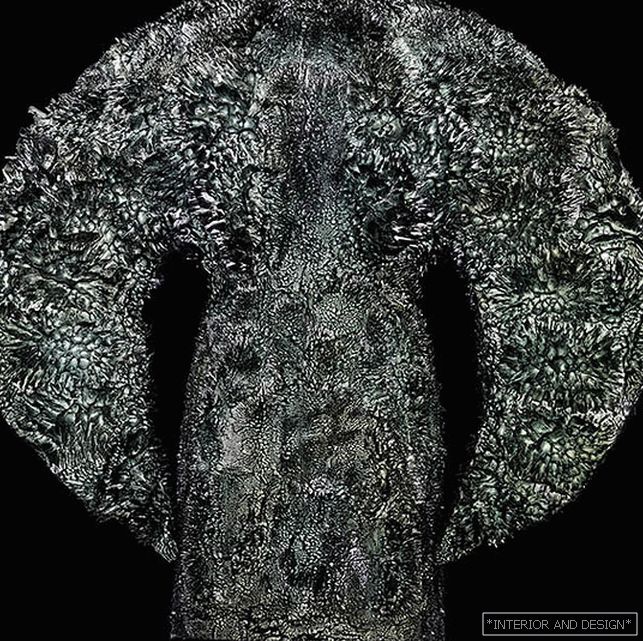 Dress Wilderness Embodied, July 2013. In collaboration with Iolan van der Wiel. Iron sawdust, polyurethane resin, cotton. Property of the author.
Dress Wilderness Embodied, July 2013. In collaboration with Iolan van der Wiel. Iron sawdust, polyurethane resin, cotton. Property of the author. 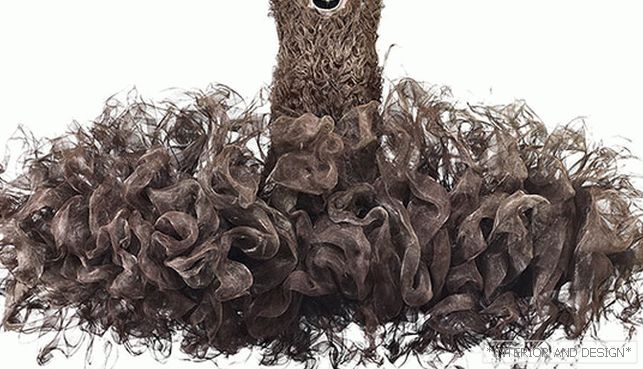 Dress Refinery Smoke, July 2008. Untreated metallic gauze, calfskin and cotton. From the collection of the Groninger Museum.
Dress Refinery Smoke, July 2008. Untreated metallic gauze, calfskin and cotton. From the collection of the Groninger Museum. In parallel with the Iris van Herpen retrospective in the United States, the Museum of Fine Arts Museum in Boston hosts an equally exciting exhibition #techstyle, which marks the same global trend: the new term and the new industry Smart fashion will define the face of fashion industry in the very near future.
The Transforming Fashion exhibition at High Museum of Art's in Atlanta will end on May 15, 2016 and will continue to tour North America. The retrospective is organized jointly with the Groninger Museum (the Netherlands).

